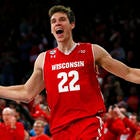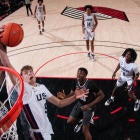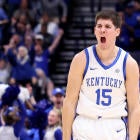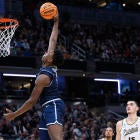PHILADELPHIA -- The Ethan Happ that Wisconsin fans have come to know is changing, hopefully for the better. One of the best players in college basketball, someone with a good shot to be an All-American two years running, is making a risky update to his game.
Happ, a 6-foot-9 junior, was tremendous last season when he was an Associated Press third team All-America selection. With no players on last season's first and second All-America teams playing college basketball this season, Happ will be one of the top returning players in the nation.
But now, thanks to a fundamental change, Happ is going to be a different guy, and it should be a fascinating transition. Happ is trying to become a mid-range and perimeter shooter -- including adding a 3-point shot to his arsenal. He's doing this with five career field goal attempts outside the paint.
And there's no guarantee it will turn out well. Happ's gambling on himself in an effort to better Wisconsin's chances in the Big Ten but also to improve his NBA stock.
"I started to tweak my shot a little bit," Happ told CBS Sports at the Under Armour All-America camp. "Then I had too many voices in my head. ... I never had confidence once I couldn't do the same thing over and over. I just lost confidence. That's basically one of the biggest changes now. I have someone who I trust, and I'm listening to him and only him. That's going to be the biggest difference. There's not too many chefs in the kitchen."
Who is this mystery person? Happ won't tell. Not yet, anyway. First, the experiment has to work. Plus, Happ is not dumb. He knows the basketball environment around him, and what's going on above him, at the next level. This isn't 1998 anymore. Big men -- power forwards, specifically -- can't be pinned in the post and find a guaranteed roster spot on an NBA team. Happ has many fortes, but his lack of a mid-range game, let alone being a commodity from 3-point land, is a glaring void on his resume.
Personal-technique renovations are infamously risky in sports; they can derail golfers' rhythm, stymie success in quarterbacks and dislodge the comfort zone for pitchers.
Not only is Happ tweaking his shot -- he's trying to relearn how to shoot altogether.
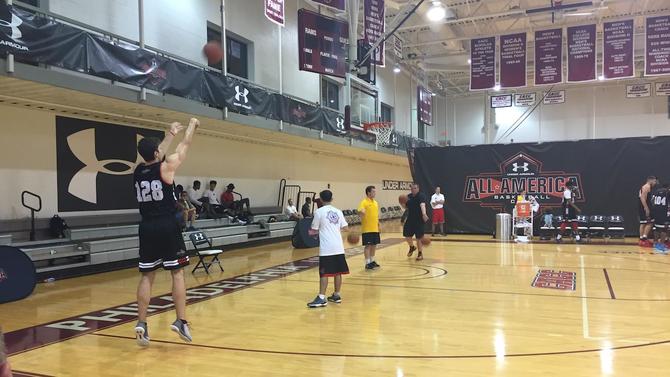
Happ averaged 14.0 points last season. He didn't make a 3-point shot -- because he never attempted one. In fact, Happ's never taken a 3 in his college career. Beyond that, remarkably, he has only five attempts from outside the paint since he got to Wisconsin (he's made two). Operating as a pure post player, Happ was terrific from the field last season and wound up as a vital source for Wisconsin's push to a 19th straight NCAA Tournament showing. He shot 59 percent, thanks in good part to grabbing 13.3 percent of Wisconsin's misses when he was on the floor.
He's efficient, reliable, methodical basketball player (he was No. 2 plus/minus in all of college hoops last season) with a knack for working the paint. But he doesn't want to be tethered anymore. At last week's Under Armour All-America camp, playing with and against 20 other high-level college players, Happ displayed his experiment publicly for the first time. It was not smooth. He missed several 3s in scrimmages at Under Armour -- some of them badly.
"Personally, I thought I played well on defense and with transition stuff, but I was trying to knock down some shots and couldn't get them to fall," Happ said. "I think if I just show progression. I was 5 for 7 from the free-throw line here, and I never took a 3 last year. If I shoot them now, start to make some, then make some more, it's better for our team."
Happ is approximately six weeks into his shooting renovation, and there are many miles to go. It will be a fascinating plot line this season, because Happ is doing this for both his team and himself. This isn't just a tweak to shooting form -- it's an all-out mission to add a mid-range and 3-point game, two factors that have been non-existent since Happ got to Wisconsin.
"It will help our team, because when they start to double- or triple-team, I need to be able to expand my game," Happ said. "But for me personally, it's to get to the next level. I could probably squeak by and get in with what I've got now, but I don't want to squeak by. I want to be an elite player and have a long career in the NBA, so I don't want that (lack of 3-point shooting) to be something that hinders me from doing that."
Happ -- a versatile defender, and spectacular stealer for a big man -- is also bringing the twist because of who he's asked to guard. He's not been tasked with busting against back-to-the-basket bruisers on a game-by-game basis. There are some (Michigan State's Nick Ward, Purdue's Isaac Haas, Michal Cekovsky at Maryland) who live in the post, but it's not that commonplace in college anymore. Things have drastically changed in the past half-decade.
Happ wasn't always allergic to the jump shot. Though a three-star recruit, he established himself as Big Ten-level prospect because he was a wing-type player with slashing and shooting ability. He grew up as a point guard, played it all the way into his early varsity years, then transitioned into a stop-and-pop, cut-and-shoot player. But in his redshirt freshman year, Happ was the tallest guy on the scout team and was asked to park in the post. He was so good, so effective, that role translated in full to the floor when he played in 2015-16 as a redshirt freshman. In 2016-17, Happ was even better -- but his free throw shooting oddly got even worse.
He's always kept the same sequence at the foul line (two dribbles, spin the ball, shoot), but his average has cratered. Ironically, Happ began his career as a great free throw shooter, making 27 of 32 attempts (84.4 percent) in his first 10 games. Then he missed nine foul shots in three games and sought to tweak his form. Then tweaked it again. It fell apart. By the end of that season, he was a 64-percent foul shooter. In 2016-17, it got worse: Happ was 50 percent from the line while in search of an answer. It reached the point where Gard had to bench him during offensive possessions in the final minute because he was a liability from the charity stripe.
Happ has changed the location of his left palm on the ball and his point of release. This is in effect for both foul shots and perimeter attempts. Before, his left hand was too far over and on top of the ball. He's still working on muscle memory.
"I need to get hundreds of thousands of reps with my left hand in the position I want it to be -- that way in a game that doesn't happen," Happ said, referencing his reversion at UA camp. "My right hand knows the distance. I grew up being a point guard, I'm a good shooter, but my [left hand] doesn't go where it's supposed to yet."
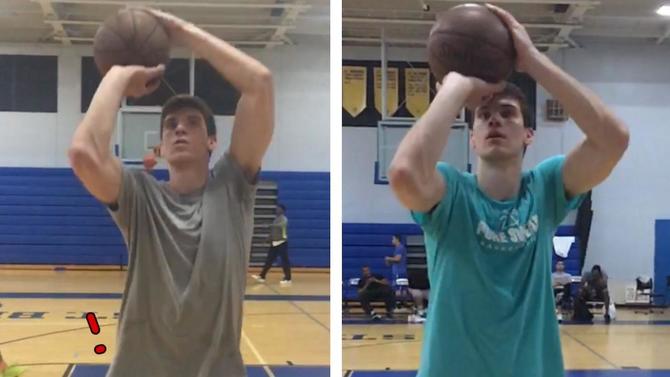
For the first time in ages, Wisconsin enters a season as a curiosity, a question mark, regarding its overall standing in the Big Ten. There have been reasons to (foolishly, they would prove to be) doubt Wisconsin in years past, but 2017-18 is validly different. Greg Gard is in his second full year as Badgers coach, and the majority of the young roster is guys he's brought in for his system in the post-Bo Ryan era.
The Big Ten is going to be crowded at the top. Where Wisconsin fits among that crowd is to-be-determined.
Since 2001, UW has famously managed fourth or better in the Big Ten. That's a level of conference consistency that competes with the likes of perennial blueblood superpowers such as Kansas, Kentucky, Duke and North Carolina.
Wisconsin will likely find itself in the abnormal philosophical conundrum of relying heavily on one player to ensure season-long success in 2017-18. That goes against the Badgers' ethos. Wisconsin usually wins by committee, right? Even Frank Kaminsky's 2014-15 Player of the Year campaign was buttressed by Sam Dekker, Josh Gasser and then-sophomore Nigel Hayes. But the 2017-18 Wisconsin team will be fairly young, and so winning will center around Happ, who would have been the Big Ten Player of the Year if not for a double-double monster of a man named Caleb Swanigan, who left Purdue for the NBA.
Wisconsin needs shooters this season. By losing Nigel Hayes, Bronson Koenig, Zak Showalter and Vitto Brown, UW needs players to take the pressure off of Happ. He wants to help the cause by becoming a three-level option on offense.
"It's going to take in-game reps, but for me shooting, without any defense, I think I can be 35, 40 percent from 3," Happ said. "It's going to take the confidence of seeing a couple go in."
He's also not abandoning what he does best.
"That's the bread and butter for me, being in the post," Happ said. "This is just a bonus, really. ... I'm not going to get 3-happy, but when it's open, I'm going to take them."
The big mystery here is to see what happens if Wisconsin gets six, seven, eight games into the season and Happ is shooting an abysmal rate from outside 10 feet. Will Gard allow him to keep trying? Happ's aiming to be a 70-percent foul shooter by the end of November, with that number ticking closer to 75 percent come March. There is no set goal for his perimeter shooting just yet.
"Hopefully the ball doesn't stick as much, just because we're so young," Happ said of this season's squad. "Nobody has certified themselves as guys we need to go to every time. It's going to be move, move, swing, swing, shoot."
The majority of his offensive production should come in the post, but having four or six points per game come by way of the occasional mid-range jumper or spot 3-pointer will boost Wisconsin's chances -- if this works. In the big picture, it seems like the Badgers' hopes of competing in the Big Ten and landing a good NCAA Tournament seed will rest on Happ's shooting prowess, both at the foul line and from 15 to 22 feet. We seldom see such a good player opt to overhaul their game like this. What makes it even more compelling is not knowing if it's going to work.












